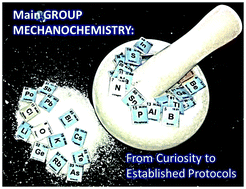Main group mechanochemistry: from curiosity to established protocols†
Abstract
In the last few decades, mechanochemistry has become rapidly established as a powerful tool enabling environmentally-benign and sustainable chemical syntheses. Not only have these techniques been demonstrated as viable alternatives to traditional solution-based syntheses, but they have also received attention for their ability to enable new reactivity and “unlocking” novel compounds inaccessible by conventional methods. Reflecting the rising popularity of mechanochemistry, many excellent reviews highlighting its benefits have recently been published. Whilst the scope of most of these focuses on organic chemistry, transition-metal catalysis, porous framework materials, coordination compounds and supramolecular synthesis, few have addressed the use of mechanochemical ball milling for the synthesis of compounds containing s- and p-block elements. This tutorial review turns the spotlight towards mechanochemical research in the field of inorganic main group chemistry, highlighting significant advantages that solid-state inorganic reactions often possess, and the potential for these to drive the development of greener methodologies within the modern main group arena.



 Please wait while we load your content...
Please wait while we load your content...